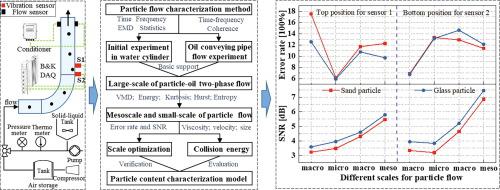Chemical Engineering Journal ( IF 13.3 ) Pub Date : 2021-03-02 , DOI: 10.1016/j.cej.2021.129173 Kai Wang , Yichen Li , Yinan Hu , Min Qin , Gang Liu , Gang Wang

|
Although the characterization and identification of solid particle-wall collision behaviours within oil-conveying flows are important, these issues, which are closely associated with the optimization of particulate systems in the chemical and petroleum industries, are rarely discussed in the literature. In this work, a series of multi-scale vibration analysis methods were proposed for the quantitative characterization and identification of sand/glass features in an oil-conveying pipe flow. Dilute particles were identified within an oil-conveying flow in the 2-D time-frequency plane and then verified by the coherence method with dual sensors. The particle-wall collision features were analysed at multiple resolutions by empirical/variational mode decomposition (EMD/VMD) in combination with statistics for each intrinsic mode function (IMF) component. Corresponding verification experiments were performed, and good agreement was found between the test conditions (oil viscosity of 10–50 mPa·s, velocity of 1.8–3.0 m/s, and particle size of 160–270 μm) and multi-scale vibration energy (SE) responses at multiple bandwidths (the macro-scale bandwidths of 30–50 kHz and 40–50 kHz, meso-scale bandwidth of 45–50 kHz, and micro-scale bandwidth of 40–42 kHz). Particularly, a solid content model was established with variations in the oil viscosity h(μ), flow velocity G(v) and particle size p(s), expressed as , and the model was verified for each scale. Moreover, considering the signal-to-noise ratio (SNR) performance, the best particle characterization scales were the meso-scale and micro-scale, with good error rates of 4.92% and 5.10%. Therefore, this study complements existing particle characterization methods and deepens the current understanding of particle-wall collisions in multi-phase flows.
中文翻译:

利用双振动传感器进行实验评估,对在输油流中撞击壁的稀固体颗粒进行多尺度表征和鉴定
尽管在输油流中表征和识别固体颗粒-壁碰撞行为很重要,但是与化学和石油工业中的颗粒系统优化密切相关的这些问题在文献中很少讨论。在这项工作中,提出了一系列多尺度振动分析方法,用于定量表征和识别输油管道中的沙/玻璃特征。在二维时频平面内的输油流中识别出稀释的颗粒,然后使用双传感器通过相干方法进行验证。通过经验/变异模式分解(EMD / VMD),结合每个固有模式函数(IMF)组件的统计数据,以多种分辨率分析了粒子-壁碰撞特征。E)在多个带宽上的响应(30–50 kHz和40–50 kHz的宏观尺度带宽,45–50 kHz的中尺度带宽和40–42 kHz的微观尺度带宽)。特别地,建立了具有油粘度h(μ),流速G(v)和粒径p(s)变化的固含量模型,表示为,并针对每个比例尺对模型进行了验证。此外,考虑到信噪比(SNR)性能,最佳的颗粒表征尺度是中尺度和微观尺度,具有良好的错误率,分别为4.92%和5.10%。因此,本研究是对现有颗粒表征方法的补充,并加深了当前对多相流中颗粒-壁碰撞的理解。











































 京公网安备 11010802027423号
京公网安备 11010802027423号